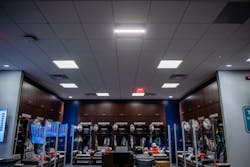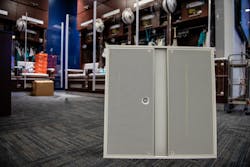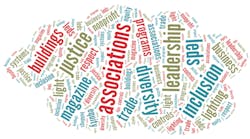Once again, UV-C LED maker Crystal IS has worked its chips inside of a ceiling-mounted air circulation system to deactivate the coronavirus in occupied rooms. This time, however, the unit is not nominally a fan. Rather, it's an ambient lighting troffer from Healthe Inc, equipped with air filtration mechanisms.
Healthe has installed about forty 2×2-ft fixtures into dropped ceilings inside the locker room and other facilities for the Miami Dolphins football team in Miami Gardens, FL.
Each “Healthe Air” troffer has a long, narrow visible light strip of LEDs running down its middle, pointing down for illumination. To either side are rectangular meshes that form an air system. The intake side houses a HEPA (high efficiency particulate air) cleaning system, with fans designed to draw in air for purification by the the UV-C LEDs. It also has a charcoal filter to eliminate odors. Clean air exits via the outlet side.
A dozen Crystal IS UV-C LEDs drawing 60 mW of power each and emitting at 265 nm sit enclosed inside the HEPA system, Crystal IS CEO Larry Felton told LEDs Magazine. UV-C is invisible radiation associated with the light spectrum. It is part of the ultraviolet bandwidth. At between 100 and 280 nm, it is shorter than “A” and “B” band UV. UV-C has been proven to deactivate SARS-CoV-2 in different light-source forms — of recent note, mainly as mercury-vapor lamps.
The enclosed design serves at least two purposes. It points the UV-C LEDs directly at the circulating air. It also acts as a shield preventing the UV-C from contacting people in the room. UV-C is hazardous to skin and eyes.
The partnership with Melbourne, FL-based Healthe marks at least the second time Crystal IS has teamed with another company to boost the effectiveness of UV-C deactivation by adding air circulation. In another example, but one that does not include ambient lighting, Crystal is providing 265-nm UV-C chips to Lexington, KY-based Big Ass Fans, which builds the chips into ceiling fans that it has supplied to Carnegie Mellon University for classroom use and to the Orangetheory fitness chain for gyms.
Crystal IS, based in Green Island, NY near Albany and owned by Japanese conglomerate Asahi Kasei, has a stable of germicidal UV-C LEDs branded Klaran and targeting pathogens including viruses, bacteria, and endospores for use in treating water, air, and surfaces. The company has been expanding into coronavirus deactivation amid the pandemic, building devices not just for fans and luminaires but also for UV-C chambers such as one made by Nashville, TN-based Cleanbox.
It develops UV-C LEDs that emit radiation between 260 to 270 nm, which Felton pointed out is more effective against SARS-CoV-2 than the 275–280-nm spectrum that some other UV-C LED manufacturers use. (Osram Opto Semiconductors this week introduced a UV-C packaged LED at 275 nm).
Crystal IS uses an aluminum nitride (AIN) substrate rather than a sapphire substrate. It is the AIN approach that enables Crystal to tap the 260–270-nm range, Felton said.
The Miami Dolphins installation marks another case of a major league sports team deploying UV-C to combat the coronavirus in its facilities. In Europe, Signify has outfitted soccer clubs PSV Eindhoven in Holland and RB Leipzig in Germany. Signify also recently outfitted an Edeka supermarket outlet in Hamburg, Germany, with UV-C disinfection capability.
Signify's push into UV-C does not use LED technology. Rather, it is based on conventional mercury-vapor technology. Signify CEO Eric Rondolat has been dismissing UV-C LED for the time being, explaining to LEDs more than once this year that in their current state UV-C systems would require many more LED light sources than would be practical on both a cost and energy consumption basis.
In a June webcast from LEDs earlier this year, Bob Karlicek, director of the Center for Lighting Enabled Systems & Applications (LESA) at Rensselaer Polytechnic Institute (RPI) noted that UV-C LEDs could benefit from improvements in power efficiency, and was optimistic that those improvements would come.
Suppliers like Crystal IS and their partners such as Healthe and Big Ass Fans clearly believe their moment has arrived.
“Times change,” Felton told LEDs. “What Signify said was probably very, very true three years ago. But like any lighting technology, UV-C LEDs will do the same thing that visible light LEDs did. As the volumes go up, the price will go down.”
So how much does a Crystal IS UV-C LED cost?
“What we tell people publicly is we sell LEDs for less than 20 cents a milliwatt,” Felton said. “That means the 60 mW LED would be $12.” Healthe, Big Ass Fans, and other Crystal IS customers are believed to pay less than that via supply agreements.
In the general UV-C market, a user's choice of LED versus mercury vapor can come down to the relative merits of each.
“This mercury lamps versus LED thing is very application specific,” Felton said.
Mercury vapor UV-C is by and large less expensive. Healthe founder and chief scientific officer Fred Maxik told LEDs that it is about “one quarter of the cost” of the 265-nm Crystal IS LEDs.
And as Felton acknowledged, mercury vapor also generally lasts longer than UV-C LEDs — that is, when when mercury vapor tubes don't prematurely fail as can happen as a result of rigorous on/off cycles. Also, being glass, they can break.
UV-C LEDs hardly have the decades-long lifetime often ascribed to LEDs in general. Felton noted that Healthe recommends replacing the UV-C LEDs in the ceiling unit every 3000 hours, or roughly every 18 months, assuming the system runs at full power. At lower power the LEDs will last longer.
There are other tradeoffs. Felton noted that whereas mercury vapor wins hands down at wall plug efficiency — 33% for a 25W version versus only about 2% for Crystal IS' 60-mW chip — UV-C LEDs are 10% more efficient when deactivating pathogens. And they are far more efficient optically, because as point sources they can be directly aimed at a target, compared to mercury tubes that deliver light in all directions.
In yet another option, Healthe is also offering a 222-nm source, using neither LED nor mercury vapor but rather excimer lamps, which can be safer than either 254 nm or 265 nm, Healthe's Maxik noted. The 222-nm wavelength is also known as far UV-C. Healthe brands it as Healthe Space.
“It has a novel property,” Maxik said. “If there is incidental exposure to human beings, it is harmless.” While several studies have backed up this claim, it is true at lower power doses. Healthe has built far UV-C into decorative lights for restaurants and upmarket retailers, where dropped ceilings are out of the question because they would be unsightly. A set of 265-nm chips hidden away inside troffers would thus not be an option as they were at in the Dolphins' locker room.
Tradeoffs apply to far UV-C as well. For example, they can be the most expensive option of all.
Healthe is supplying far UV-C to Boll & Branch retail outlets in Greenwich, CT and Boca Raton, FL; to two restaurants with the same owner in Alexandria, VA — Mia’s Italian Kitchen and Vola’s Dockside Grill; to three production facilities run by organic snack company Nature's Path; and elsewhere.
It also recently introduced a far UV-C wheeled trolley called the Healthe Wand Pro designed to purify quick changeover environments such as planes and trains, as well as showrooms, offices, restrooms, and other settings. A high-power version, at 750W, is hazardous to humans, so it cannot be generally used when people are present. Operators have to wear protective gear. It will become available in February.
LEDs Magazine will bring you more reports on these UV-C products and installations as well as on others.
MARK HALPER is a contributing editor for LEDs Magazine, and an energy, technology, and business journalist ([email protected]m).
*Updated Dec. 18, 2020 2:20 PM for correction to nm, clarifications on the air system and associated photo captions.
For up-to-the-minute LED and SSL updates, why not follow us on Twitter? You’ll find curated content and commentary, as well as information on industry events, webcasts, and surveys on our LinkedIn Company Page and our Facebook page.






